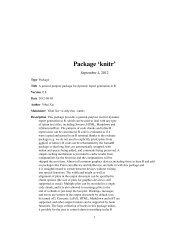Package 'openair'
Package 'openair'
Package 'openair'
Create successful ePaper yourself
Turn your PDF publications into a flip-book with our unique Google optimized e-Paper software.
polarPlot 95auto.textEither TRUE (default) or FALSE. If TRUE titles and axis labels will automaticallytry and format pollutant names and units properly e.g. by subscripting the ‘2’ inNO2.... Other graphical parameters passed onto lattice:levelplot and cutData. Forexample, polarPlot passes the option hemisphere = "southern" on tocutData to provide southern (rather than default northern) hemisphere handlingof type = "season". Similarly, common axis and title labelling options (suchas xlab, ylab, main) are passed to levelplot via quickText to handle routineformatting.DetailsThe bivariate polar plot is a useful diagnostic tool for quickly gaining an idea of potential sources.Wind speed is one of the most useful variables to use to separate source types (see references).For example, ground-level concentrations resulting from buoyant plumes from chimney stacks tendto peak under higher wind speed conditions. Conversely, ground-level, non-buoyant plumes suchas from road traffic, tend to have highest concentrations under low wind speed conditions. Othersources such as from aircraft engines also show differing characteristics by wind speed.The function has been developed to allow variables other than wind speed to be plotted with winddirection in polar coordinates. The key issue is that the other variable plotted against wind directionshould be discriminating in some way. For example, temperature can help reveal high-level sourcesbrought down to ground level in unstable atmospheric conditions, or show the effect a source emissiondependent on temperature e.g. biogenic isoprene.The plots can vary considerably depending on how much smoothing is done. The approach adoptedhere is based on the very flexible and capable mgcv package that uses Generalized Additive Models.While methods do exist to find an optimum level of smoothness, they are not necessarily useful.The principal aim of polarPlot is as a graphical analysis rather than for quantitative purposes. Inthis respect the smoothing aims to strike a balance between revealing interesting (real) features andoverly noisy data. The defaults used in polarPlot are based on the analysis of data from manydifferent sources. More advanced users may wish to modify the code and adopt other smoothingapproaches.Various statistics are possible to consider e.g. mean, maximum, median. statistic = "max" isoften useful for revealing sources.Wind direction is split up into 10 degree intervals and the other variable (e.g. wind speed) 30intervals. These 2D bins are then used to calculate the statistics.These plots often show interesting features at higher wind speeds (see references below). For theseconditions there can be very few measurements and therefore greater uncertainty in the calculationof the surface. There are several ways in which this issue can be tackled. First, it is possible toavoid smoothing altogether and use polarFreq. Second, the effect of setting a minimum numberof measurements in each wind speed-direction bin can be examined through min.bin. It is possiblethat a single point at high wind speed conditions can strongly affect the surface prediction. Therefore,setting min.bin = 3, for example, will remove all wind speed-direction bins with fewerthan 3 measurements before fitting the surface. Third, consider setting uncertainty = TRUE.This option will show the predicted surface together with upper and lower 95 which take accountof the frequency of measurements.Variants on polarPlot include polarAnnulus and polarFreq.
















